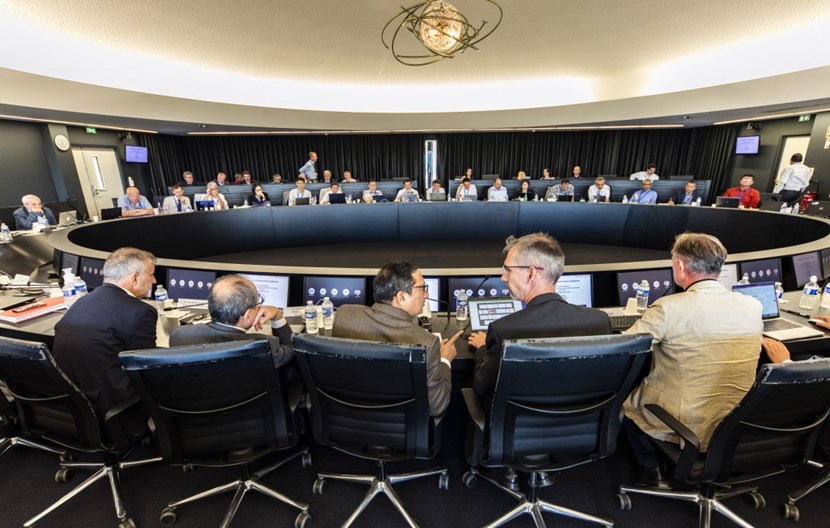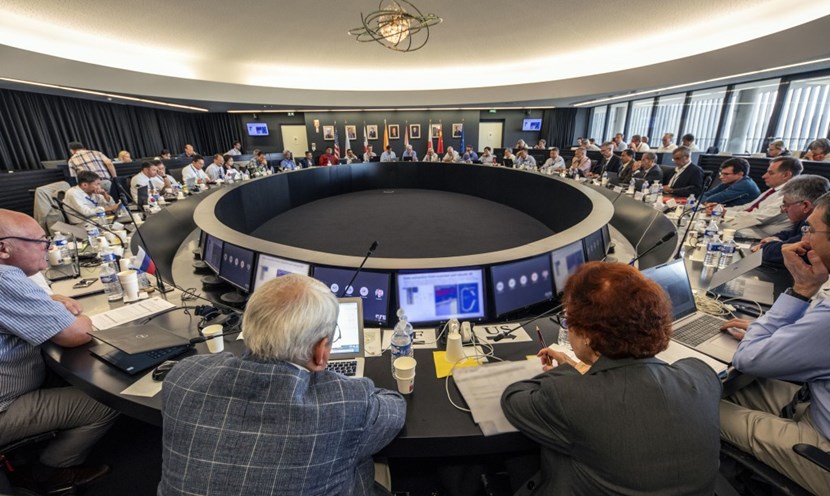ITER NEWSLINE
-
ITER Baseline
STAC committee reviews new plans for construction and operation
Alberto Loarte, Head of the Science Division
ITER Baseline | STAC committee reviews new plans for construction and operation
Last week, the ITER Council Science and Technology Advisory Committee (STAC) met at ITER Headquarters to review the new plans for construction and operation proposed by the ITER Organization and Member's Domestic Agencies. This was the first in-person STAC meeting after a hiatus of almost four years caused by the pandemic.

The STAC advises the ITER Council on science and technology issues that arise during the course of ITER construction and operation. Foreground, centre: STAC Chair Shishir Deshpande sits with ITER Organization representatives (left) ITER Director-General Pietro Barabaschi, ITER Deputy Director-General for Science and Technology Yutaka Kamada, (right) Simon Pinches (Plasma Modelling & Analysis Section Leader), and Jens Reich (Machine Assembly Program Manager).
These new plans reviewed by STAC have been elaborated to minimize the impact of the repairs of the vacuum vessel and thermal shields on nuclear operation as well as to provide a more robust path to ITER licencing and to the routine demonstration of the Q=10 goal. In this new approach, ITER operation is proposed to be divided into three main phases:
Augmented First Plasma (AFP): In this phase ITER will be equipped with inertially cooled plasma facing components in the critical areas of the first wall, which will allow demonstration of 15 MA operation and the commissioning of all required systems, including the disruption mitigation system with low operational risks. Deuterium plasmas with high confinement (H-mode) will also be demonstrated.
DT-1: In this phase ITER will be equipped with a fully water cooled first wall and additional heating power of 33 MW neutral beam heating, 67 MW of electron cyclotron heating (ECH) and 10-20 MW of ion cyclotron heating (ICH). This phase will explore high confinement plasmas at high levels of plasma current in deuterium and deuterium-tritium plasmas culminating in the demonstration of reproducible operation of Q=10 burning plasmas within an accumulated neutron fluence of ~ 1% compared to the final ITER project goal.
DT-2: In this phase ITER will be in its final configuration with the objective of demonstrating Q=5 long-pulse and steady-state scenarios and routine operation at high Q with high fluence neutron production. This will allow the study of physics scenarios and technological choices for future electricity-producing fusion reactors.
To support these operational phases the configuration of the ITER device and its ancillaries will be modified. These modifications include a change of first wall material from beryllium to tungsten, which is foreseen to reduce the retention of tritium inside ITER's vessel and the production of dust, and to increase the resilience of in-vessel components to disruptions. Since a change from beryllium to tungsten can increase the cooling of the plasmas and decrease fusion power production, this change is accompanied by risk-mitigation technical modifications to ITER ancillary systems. These include the introduction of systems to deposit films of boron to maintain good vacuum conditions and to cover tungsten components, if needed, and an increase of the power available to heat the plasmas with a change of proportion between ECH and ICH radiofrequency heating from that assumed in the 2016 ITER Baseline.

Last week's STAC meeting was the first in-person reunion after a hiatus of almost four years caused by the pandemic.
The STAC reviewed the proposed modifications and supported the risk mitigation measure proposed by the ITER Organization in the context of the change of wall material and the new operational plan with the AFP, DT-1 and DT-2 phases. In particular, STAC supported the inclusion of a boronization system based on glow discharge cleaning and recommended the development of the technology for a boron dropper as ultimate risk mitigation in ITER. STAC also endorsed the plan for 40 MW ECH power in AFP with a further upgrade to 67 MW in DT-1. For ICH, STAC recommended to install 10 MW for AFP with a further increase to 20 MW in DT-1, after its effectiveness in an all-tungsten ITER has been confirmed during AFP.
With regards to the AFP/DT-1/DT-2 outline operational plan, STAC found the plan compelling and recommended that this outline plan be adopted for the further articulation of the new ITER Research Plan to be elaborated by the ITER Organization and Members' experts. STAC also noted the new approach to a staged licencing of ITER through the three operational phases above, and endorsed this new licencing strategy and the principles upon which it is based.
STAC also reviewed progress and the strategy for the construction of the ITER Tokamak including the repair of vacuum vessel sectors and thermal shields. STAC found the proposal to perform cold testing of the magnets to be important to mitigating technical risks and recommended that, if possible, all the toroidal field coils and poloidal field coil # 1 be tested.
In the words of ITER's Deputy Director-General for Science and Technology Yutaka Kamada, "The ITER Organization is now fully confident that the New Baseline represents a robust approach to completing ITER construction and its licencing as well as for its scientific exploitation to demonstrate the project's fusion goals. The ITER Organization deeply appreciates the advice of the STAC members, who represent the world's fusion science and technology expertise, for their strong support to ITER and their productive suggestions for improving the New Baseline."
In the coming weeks, the ITER Council Management Advisory Committee (MAC) and the ITER Council itself will have the opportunity to review and comment on the ITER Organization's new plans for ITER construction and operation with the objective of submitting a final version of these plans for review and approval by the ITER Council in 2024.
return to the latest published articles








